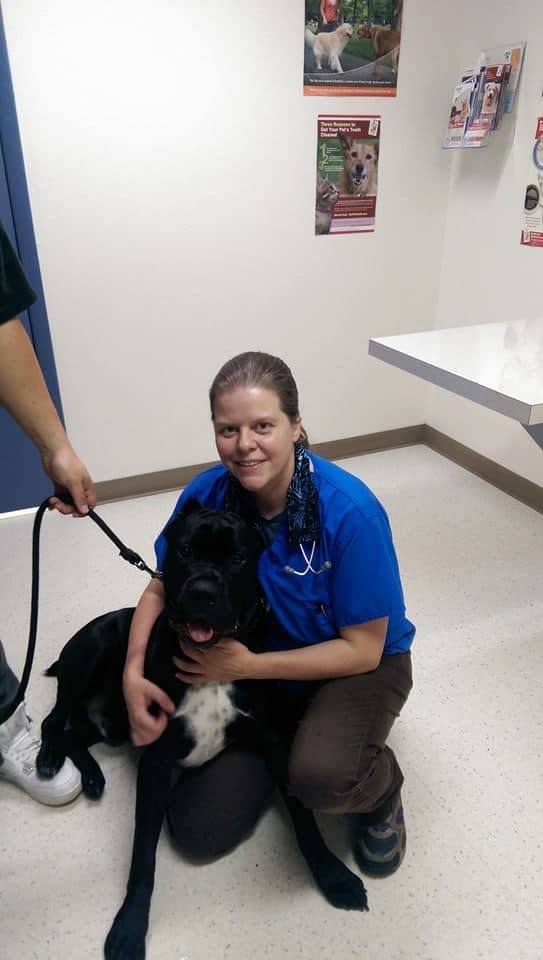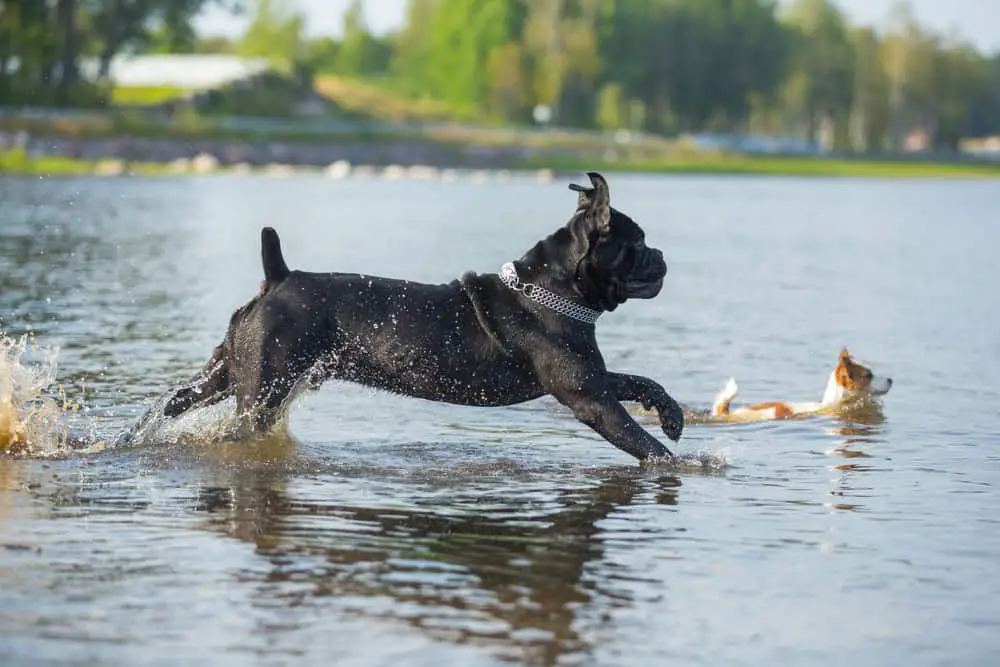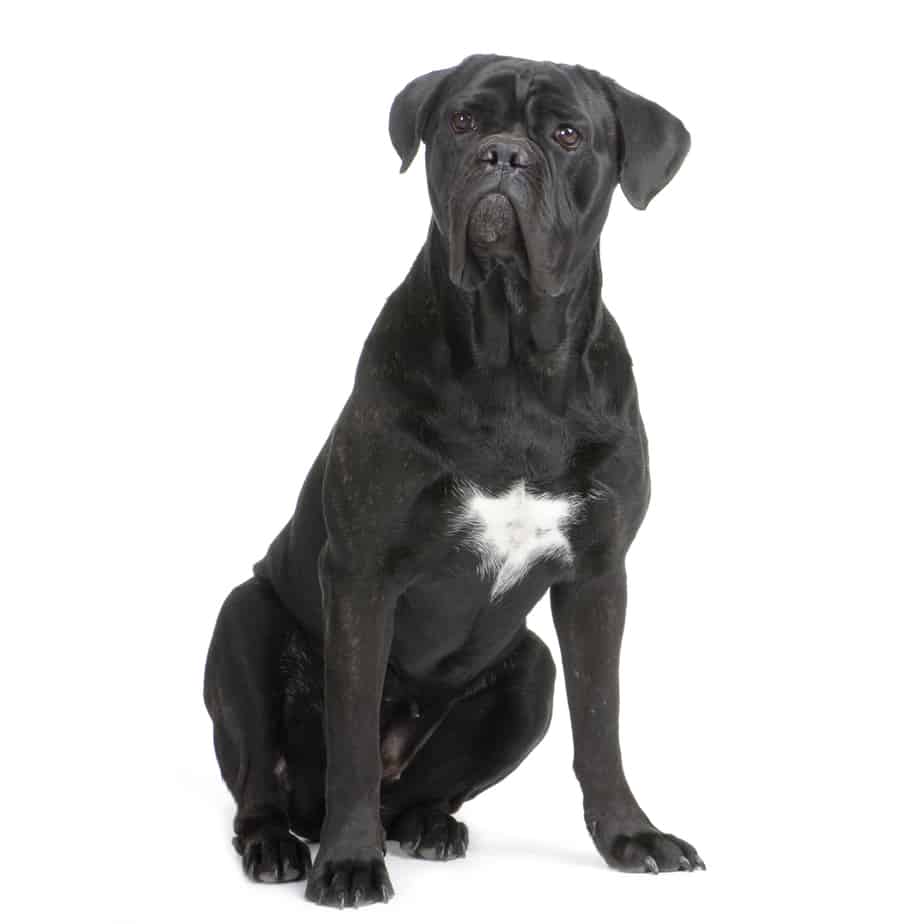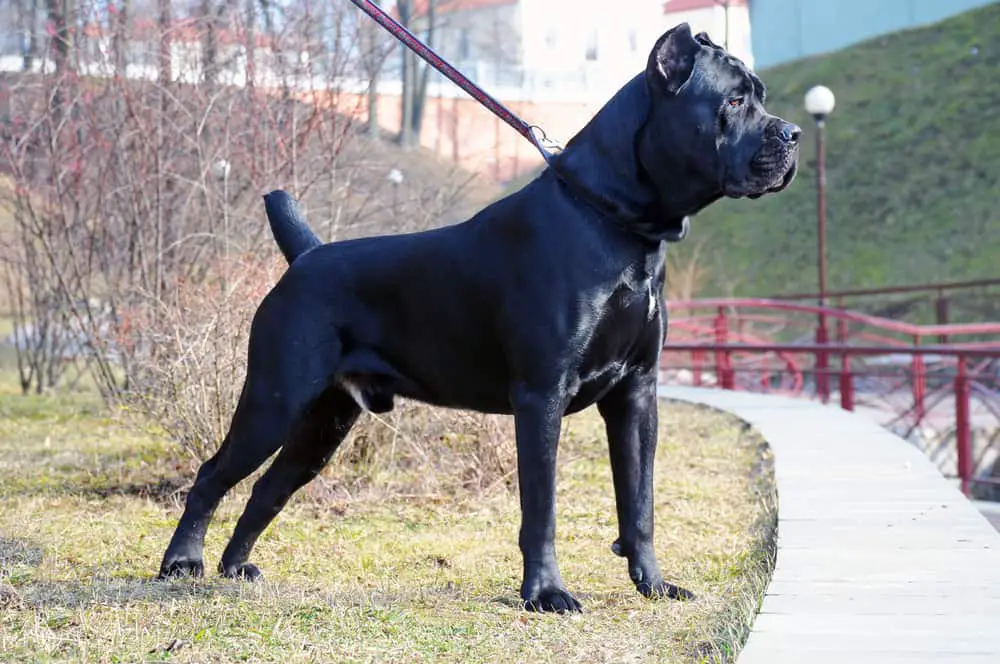Complete Guide To The Cane Corso: Health, Exercise, Feeding and More
The Cane Corso’s impressive physical presence puts intruders on notice. Bred to protect, they’re fearless, intelligent and loyal with a softer side that makes them unparalleled companions for the right family.
As a veterinarian with over 20 years experience, I’ve seen many sides of this breed. With conscientious breeding and the right upbringing, this is a fantastic dog. However, read below to find out what you should know before acquiring a Cane Corso.

Table of Contents
How Big Do Cane Corso Get?
| Height | Weight | |
| Male | 25″-27.5″ at the shoulder | 90-120 lbs |
| Female | 23.5″ – 26″ at the shoulder | 70-90 lbs |
The breed standard doesn’t list a specific weight for this dog. They say it should be “proportionate to the height.” As these are muscular dogs, the height does directly impact on how much they will eventually weigh. However, I’ve added dog weights that correspond to my experience with the breed.
What Do Cane Corso Look Like?
Their short, coarse coats come in seven AKC-approved colors:
• Black
• Black Brindle
• Fawn
• Gray
• Red
• Chestnut Brindle
Black or gray masks and white patches on the chest are common markings. Historically, tails are docked at the fourth vertebrae, and ears may be cropped or left natural — judges show no preference in the ring. Often mistaken for its larger cousin, the Neapolitan Mastiff, the Cane Corso bears a resemblance to the Bullmastiff and Rottweiler.
What is the Personality Of A Cane Corso?
The Cane Corso is justifiably self-assured and a capable protector. Eager to please, they form lasting bonds with their social group and are good-natured unless provoked.
Imposing, they can be pushy with submissive people, so owners should be comfortable taking the lead with large dogs before considering the breed. Early socialization and obedience training are musts to keep dominant behavior in check. Non-breeding male dogs should be neutered.
Affectionate and fun-loving, the Cane Corso is happiest with a mission — they get and destructive spending long hours alone. Exercise that channels their energy and challenges their intelligence is essential. Quiet, they can be polite and content apartment dwellers if they get enough activity.

How Much Grooming Does The Cane Corso Need?
The Cane Corso’s coat is short but surprisingly thick, featuring a wooly layer close to the skin and a coarse top coat. Regular care controls year-round and seasonal shedding.
Weekly brushing with a medium-bristled brush or hound glove removes dead hair and promotes new growth — do it daily in the spring. Virtually waterproof, the Cane Corso’s coat is naturally soil-resistant, so frequent bathing isn’t necessary. Vigorous brushing alone keeps them clean.
As with all heavy breeds, overgrown nails can cause pain and should be trimmed every 2-3 weeks. Thick, their nails can be challenging to cut with the usual pet store clippers — opt for a professional, heavy-duty model or consider using a rotary tool with a sanding wheel.
Does The Cane Corso Need To Have Its Ears Cropped?
Do they need it? No, they don’t need to have their ears cropped. However, many fans of the breed prefer the look because they like it.
I’m not at all a big fan of the procedure and I’ve never learned how to do it on purpose. Right now I don’t know of anyone within 20 miles of my own veterinary practice that actually does it. I would imagine that any breeder who has been doing this a while has their own veterinarians that still agree to doing the procedure.
However, the vast majority of veterinarians have refused to do these types of cosmetic surgeries and it’s rare to find a young veterinarian willing to learn how to do it. It’s only a matter of time before cropping ears isn’t even an option and the Cane Corso look will permanently change.

How Much Exercise Does A Cane Corso Need?
These are active, powerful dogs. They love to play and romp. Although they also enjoy a long cuddle at the end of the day, the Cane Corso is a dog that has to be exercised vigorously.
- Walking
- Hiking (both walking and hiking can be done with your dog also wearing a weighted pack; the weight in the pack will help to tire your dog out faster; don’t do this if your dog has any orthopedic issues)
- Swimming
- Agility Training
- Dog Parks
As younger dogs, be mindful of how much exercise they are doing and what kind. Walking and swimming are great for growing young dogs. This is not a breed that I would take on a long run when they are still growing.
While a 15-minute run may be what’s needed to truly tire this dog out, doing it daily or increasing that run to 30 minutes or more isn’t recommended due to their large size.
What Kind Of Dog Food Is Best For A Cane Corso?
For Cane Corso puppies, you will need to make sure you don’t feed them too much too fast. It’s easy because they are usually chow hounds, but you want to control their growth. Growing too fast can cause some early bone and joint problems that are easily avoided.
Use a large-breed puppy food and follow the directions on the bag for how often and how much to feed. This is a breed that would probably benefit from transitioning to adult food by the age of 6 months to further control the growth rate.
Best Puppy Food For A Cane Corso:
Best Adult Food For A Cane Corso:
- Purina Pro Plan Large Breed
- Eukanuba Adult Dry Dog Food
- Nutro Natural Choice Large Breed Adult
- Merrick Classic Healthy Grains Dry Dog Food
Please don’t listen to the folks at the pet store trying to convince you to buy a grain-free diet for your dog. There’s zero science behind that and vets are actually seeing diseases now related to feeding grain-free foods.
Personally I believe that most foods are fine for most dogs. Some dogs may not do well on some foods. However, as a rule I don’t blanket-prohibit any dietary ingredient from any breed at this time.

How Long Does A Cane Corso Live?
9-12 years according to information from the AKC
What Health Problems Does The Cane Corso Have?
Based on my own personal experience with the breed as well as statistics from the Canine Health Information Center, the most common health conditions seen in Cane Corso include:
- Elbow Dysplasia/Arthritis
- Hip Dysplasia/Arthritis
- Shoulder issues such as OCD and arthritis
- Bloat/GDV
- Entropion/Ectropion
- Panosteitis
One way you can try and minimize arthritis and other orthopedic issues as these dogs age is by maintaining a lean weight throughout the life of a Cane Corso. You should be able to see a narrow waist between the larger chest and hip areas. Check with your vet if you’re not sure if your dog is overweight.
Due to the breed’s size and likely orthopedic issues as they age, this is definitely a dog that you should get pet insurance for as soon as you acquire them.
Where Can I Learn More About The Cane Corso?
Cane Corso Association Of America
Where Can I Find A Cane Corso?
Breeder List From The Cane Corso Association of America
Looking for a Rescue? Start here.
Interesting Facts About the Cane Corso
The Cane Corso is a relatively rare breed considering its growing popularity. Here are a few things you should know about this genteel giant.
• They’re Native to Italy
The Cane Corso is the remote descendant of Mastiff-like dogs from Greece. Imported to Italy by the Roman Legions, they were crossed with native breeds to produce dogs like the Neapolitan Mastiff and the Cane Corso we know today.
By the end of the 20th century, few dogs remained, victims of war and mechanized agriculture. But enthusiasts brought the breed back from the brink of extinction in the 1980s, forming the Society Amorati Cane Corso dedicated to its preservation.
• It’s Not a “Kane’ Corso
The name Cane Corso is pronounced “Kah-nay” Corso. The plural, Cani Corsi, sounds even more aristocratic and perhaps even scientific. It’s no wonder you may have heard about the breed as simply, “Corsos” or Italian Mastiffs.
• They’re Protectors, Not Fighters
Early versions of the Cane Corso were occasionally conscripted for war, but the modern variety is no soldier. They were bred to herd and to protect livestock and hen houses. Corsos have no history of dog fighting.
• Corsos are Cat-like
Corso may seem like a large, lumbering breed, but they’re astonishingly athletic. Nimble, they’re top canine sports stars. Reina, a brindle Corso from California, is an agility champion with her own Instagram page and aspirations to be a therapy dog.
• Their Famous Owners are Equally Athletic
The distinguished Cane Corso has acclaimed celebrity owners. Patrick Mahomes, Superbowl-winning quarterback for the Kansas City Chiefs purchased a Corso, Silver, as a companion for his pit bull, Steel. Hollywood action star, Vin Diesel, shares his home with his best friend, Roman.
• Cani Corsi Are Models for the Masters
The Cane Corso is immortalized in art. Muse to eighteenth-century illustrator and engraver, Bartolomeo Pinelli, it was the subject of famous works depicting the history of ancient Rome. Two Corso-like dogs were sculpted in the 18th-century Fountain of Diana and Actaeon, located at the Royal Palace of Caserta in Southern Italy.
• Beware of “Designer” Colors
As a relatively rare breed, the Cane Corso struggles for purity. Unscrupulous breeders have taken advantage of shoppers, selling puppies in “rare’ or “designer” colors that can’t be shown. Shades not on the AKC-approved list are the result of recessive genes and should be avoided for breeding.
